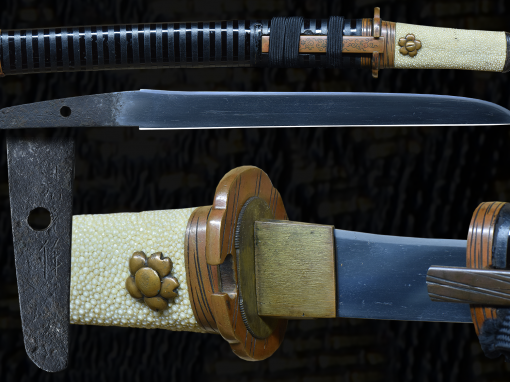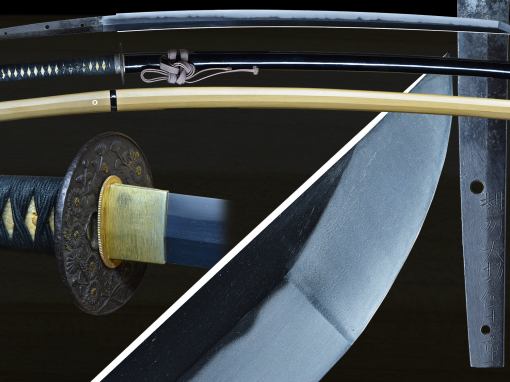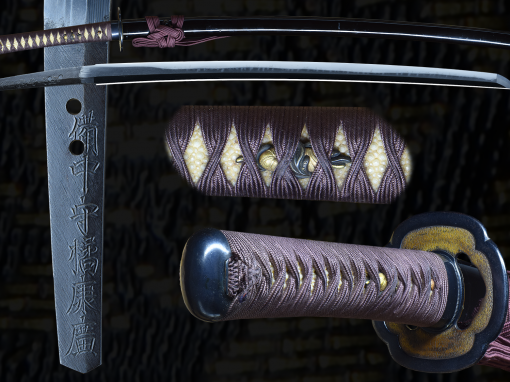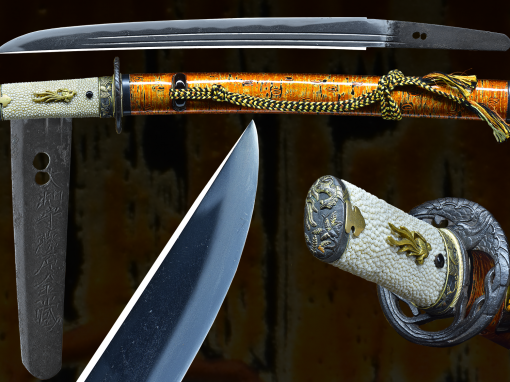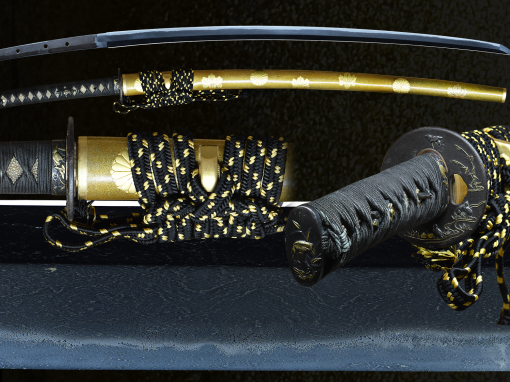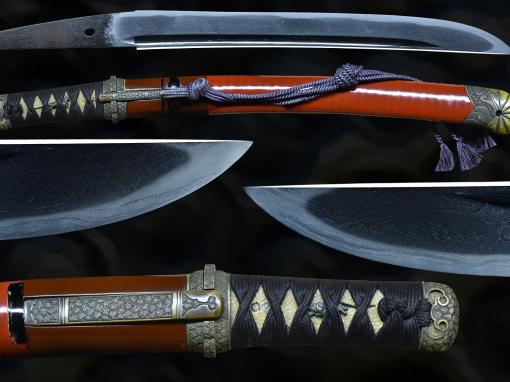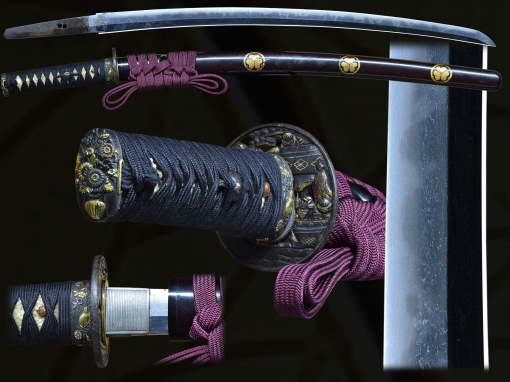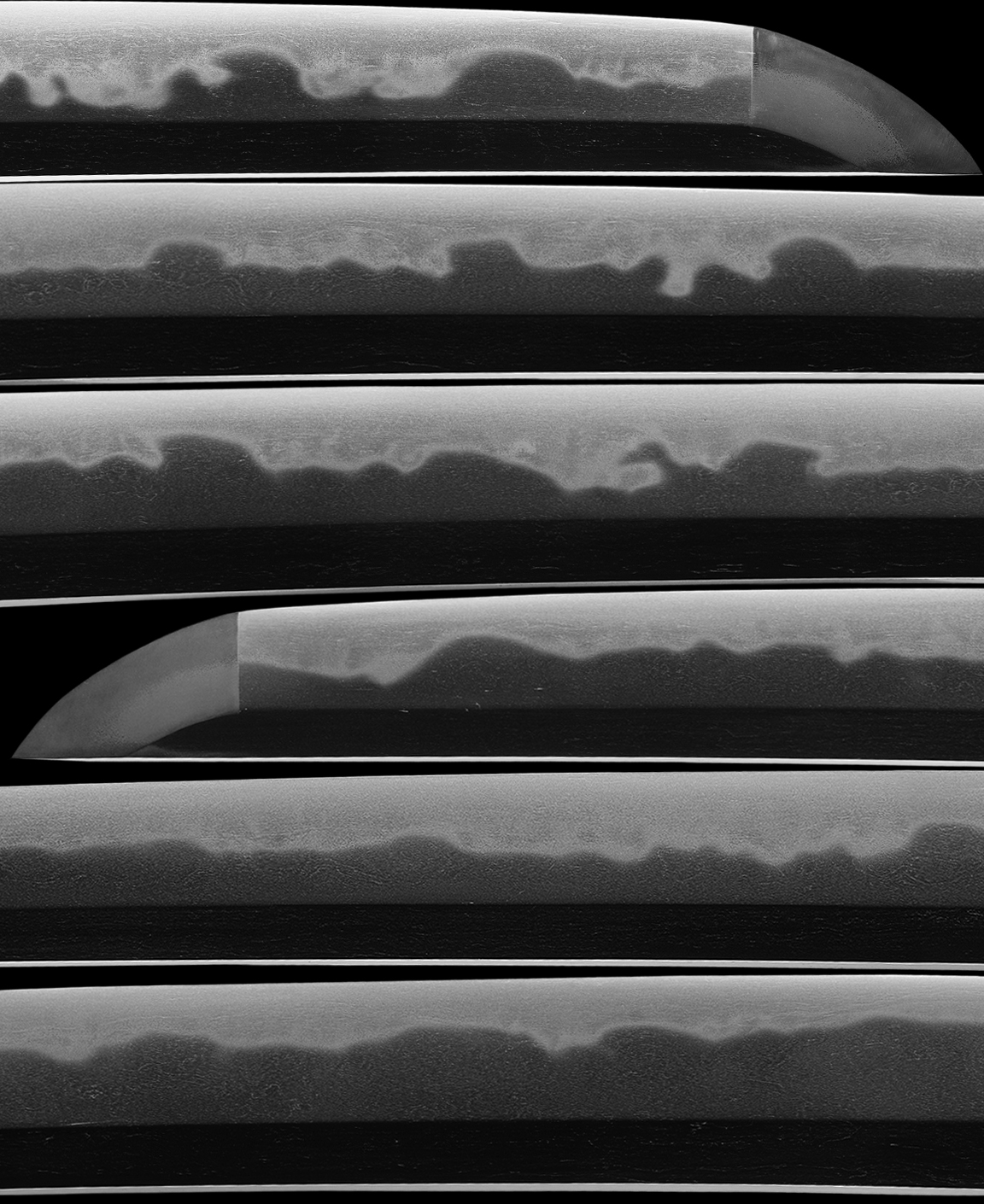Blade:
This exquisite WAKAZASHI has great workmanship and a beautiful erratic gunome midare hamon in absolutely pristine condition. It is in a fresh new polish with shirasaya. The sword is signed “. The pictures do not do justice to this sword. The hamon is very rich with a thick nioi-guchi. It has many hataraki and ji-nie appear. The hada is very well forged with a milky looking color and a tightly forged itame. A gorgeous Shinto wakazashi, it also has an elegant shape and is very well balanced. The mounts are in fantastic condition and add to the overall value of this sword. The fittings are elegant and have a quality of richness with a spectacular look and display very well. Overall this is a fine Japanese wakazashi richly adorned with the Shoki and Oni motif. The Fuchi-Kashira are of Shoki and Oni.
Mounts:
The mounts are of excellent quality from tsuka to saya. The richly finished motif beautifully complete the tsuka with an exceptional deep gold tsukaito wrap and brown sageo. The saya is an exquisite unique black finish layer with a texture of clouds.
There are gold kanji adorning both sides of the saya which read:
Namu-Hachiman (南無八幡) – the deity Hachiman
Junkoku no Ken (殉國之剣) – “The sword that I wear when I have to die for my country.”
Smith:
Kii Yasumitsu (紀伊康光)By stating Genroku (元禄, 1688-1704), the NTHK attributes this blade to the second generation Kii Yasumitsu. His predecessor was active around Enpô (延宝, 1673-1681). We also know that he was from the Uemura (上村) family and a student of the first generation Kii Yasutsuna (康綱). This means the Yasumitsu lineage belonged to the Ishidô group that stayed in Kii province when many of the other masters relocated to Ôsaka or Edo. Even Kii Yasutsuna is said to have temporarily worked in Ôsaka, what is supported by the fact that his son, the second generation Yasutsuna, is listed as a Ôsaka-based smith, i.e. he relocated there permanently.
- Mei: Kii no Kuni Yasumitsu (紀伊国康光)
- Date: Genroku (元禄, 1688-1704)
- Nagasa: 21-1/4 inches
- Sori: 12.0 mm
- Width at the ha-machi: 31.0 mm
- Width at the yokote: 19.7 mm
- Thickness at the mune-machi: 7.3 mm
- Construction: Shinogi zukuri
- Mune: Iori
- Nakago: Ubu
- Kitae: Ko- Itame
- Hamon: Gunome Choji
- Boshi: sugu with a ko-maru-kaeri
- Condition: Fresh sashikomi polish
Email us if your interested in this item and remember to include the order number for this item: fss-718.
kantei-sho (鑑定書) – Appraisal Kishû Yasumitsu (紀州康光)
shôshin (正真) – Authentic
nagasa 1 shaku 7 sun 7 bu kore ari (長さ壱尺七寸七分有之) – Blade length ~ 53.6 cm
Heisei 25 nen 8 gatsu 4 nichi (平成二十五年八月四日) – August 4th 2013 Nihon Tôken Hozon Kai (日本刀剣保存会) – NTHK
No 17,896
meibun (銘文) – Signature: Kii no Kuni Yasumitsu (紀伊国康光)
kitae (鍛) – Forging:ko-itamehamon
Hamon (刃紋) – Hardening: gunome-chôji
bôshi (鋩子) – Hardening in tip: sugu with a ko-maru-kaeri
chôkoku (彫刻) – Engravings:
nakago (中心) – Tang: mekugi-ana (目釘穴) 2, yasurime (鑢): sujikai
bikô (備考) – Remarks: around Genroku (元禄, 1688-1704)
shinsa’in natsu’in (審査員捺印) – Seals of Judges: 4 seals
Mythology:
THE LEGEND OF SHOKI THE DEMON QUELLER AND THE ONI:
Shoki and Oni are prominent folklore characters who grew out of the religious traditions of Shintoism and Buddhism in Japan and Taoism in China. Shoki, otherwise known as the Demon Queller, is regarded as the god of the afterlife and of exorcism. Oni refers to a whole host of, particularly nasty demons. According to legend, the Oni fear Shoki and so he is able to easily scare them away from their hapless human victims. Japanese families with male children used to hang images of Shoki outside their houses to ward off evil spirits during Tango no Sekku (Boys’ Day Festival), which is held annually in May. These days, the festival is for boys and girls and no doubt, Shoki is more than happy to be a protector to both!
Who is Shoki and where did all those demons come from? The story of Shoki begins in the Chinese province of Shensi, where he was known as Chung Kuei. It is said that he lived during the T’ang dynasty and that his sole aim in life was to become a physician to the royal court. Shoki completed his training and successfully passed the examinations. The legend says that he placed first of all the people who aspired to work for the emperor. However, there was one problem – Shoki was very ugly. Even though he was the best person for the job, the emperor rejected him because of how he looked.
Shoki was so distraught at seeing his dream shattered by something he had no control over, that upon hearing the news, he took his own life. He killed himself in front of the emperor on the very steps of the imperial palace. The emperor was overcome with grief and remorse for what he had said, feeling that his insensitivity had been responsible for the death of this honest and hard-working man. The emperor ordered that the Shoki be buried with the highest honors usually reserved for royalty. Shoki’s spirit, grateful to the emperor – vowed to protect him against demons.
From China, the story of Shoki traveled to Japan during the Edo period (1600 – 1868). In the Japanese myths, Shoki quells demons rather than killing them. The vanquished demons become allies and sometimes even active helpers in Shoki’s quest for good against evil. The Oni of Japanese myths are demons that have human shape. They also have three eyes, horns, and sharp nails. Oni, as described through history, represents just about all of the emotions and traits that we associate with evil and wrongdoing. Oni were said to linger around wicked people and to claim their souls when they died, transporting them by chariot to Emma-Hoo, the god of hell.
Given what they looked liked, Oni would be hard to miss except for the fact that they rarely revealed themselves to humans. They preferred to wreak their brand of havoc by causing earthquakes and other natural disasters – such as plagues. They were also famous for helping invading enemies get a foothold on native soil. One interesting note from the Buddhist tradition is that there are mythic stories of monks – good people in real life that became Oni after death in order to protect the temples they had once inhabited.Therefore, not all Oni started out as wicked people.
The Japanese do have a ceremony called Oni-Yarabi, which was designed to cleanse an infected area of the Oni demons. However, Shoki was the main person that they called on to ward off the demons. Japanese folklore has always been rich with belief in demons and spirits. These stories sprang from mythology and superstitions carried over from various religious traditions. These stories explain events in nature that might have been otherwise difficult to understand. Among these stories, Shoki and Oni remain some of the most colorful and definitely a national favorite throughout time.
For Sale
